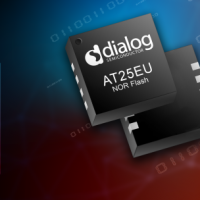Lowest energy flash memory chip for the IoT

Dialog Semiconductor has launched a NOR flash memory chip that it says is the lowest energy available.
The AT25EU focuses on achieving the lowest power consumption and the fastest operation in order to achieve the lowest energy for IoT.
Lower total energy consumption without sacrificing performance is a key differentiation of the AT25EU product family when compared to existing SPI NOR Flash solutions. Offering industry-leading low-power high-speed read operation, the family also boasts significantly faster erase times at a fraction of the power.
For example, the 2Mbit AT25EU0021A can perform a full-chip erase in under 10ms while consuming less than 1 percent of the energy demanded by competing devices, which can take a full second, or longer, to perform the same operation. The ability to achieve faster, lower energy erase operations improves the efficiency of functions such as Over-the-Air updates (OTA), event tracking, and data logging activities.
“The breakthrough low-energy consumption and high-performance for SPI NOR Flash build on Dialog’s commitment to improving performance while lowering the power and cost of IoT devices,” said Raphael Mehrbians, VP of Industrial Standard Products (ASSP) Business Unit.
The ultra-low energy Flash memory family also offers a variety of power-saving features including wide Vcc (1.65V to 3.6V) operation to extend the battery life as well as the 100 to 300nA deep power-down mode to conserve energy when the product is not in use.
The fast erase time, in conjunction with the low-power high-speed operation, reduces the total energy consumed in any system. This makes it suitable for extending the operational time of small battery-powered IoT devices.
The first of the AT25EU product family of devices will be offered in 1Mbit and 2Mbit configurations and generally available for sampling in the second quarter of 2021. Additional devices in this family are planned for up to 16Mbits density.
